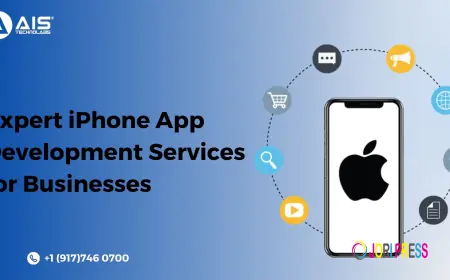Why Cross Platform Software Development Beats Native in 2025
The software industry in 2025 is moving faster than ever, and the debate between native and cross-platform development is no longer just about performance
Introduction: The Shifting App Development Landscape
The software industry in 2025 is moving faster than ever, and the debate between native and cross-platform development is no longer just about performance—it’s about strategy, speed, and scalability. Businesses today operate in a digital-first economy where users expect applications to be available instantly, work flawlessly on every device, and keep up with rapidly changing technology trends. In this environment, Cross Platform Software Development has emerged as the smarter, more agile choice over traditional native development.
A Cross Platform Software Development Company can build applications that run seamlessly on multiple operating systems, delivering consistent user experiences without the need for separate codebases. From small startups testing MVPs to global enterprises managing complex product ecosystems, Cross Platform Software Development services provide a competitive edge by cutting costs, accelerating time-to-market, and future-proofing technology investments.
In 2025, the reasons businesses choose Cross Platform App Development over native have only become stronger. Let’s explore why.
Native vs. Cross Platform: Understanding the Core Difference
Native app development involves building separate applications for each platform—typically iOS and Android—using platform-specific languages and tools. While this approach can deliver top-tier performance and full access to device features, it comes with a significant drawback: duplication of effort.
Cross Platform Software Development, on the other hand, allows developers to write code once and deploy it across multiple platforms. Frameworks like Flutter, React Native, and Xamarin enable applications to run on iOS, Android, and even the web with a unified codebase. This approach doesn’t just save time—it aligns perfectly with the fast-paced, budget-conscious demands of 2025’s business environment.
A Cross Platform Software Development Company that specializes in modern frameworks can now deliver performance levels nearly indistinguishable from native apps while offering broader reach and reduced maintenance complexity.
Why Cross Platform Wins on Time-to-Market in 2025
Speed is one of the most decisive factors in software success today. Launching an app even a few months late can mean losing market share to competitors. With native development, creating and maintaining two (or more) separate codebases doubles the work required for feature updates, bug fixes, and testing.
Cross Platform App Development services solve this problem by enabling simultaneous deployment across platforms. Businesses can:
-
Launch MVPs faster to validate ideas in real markets.
-
Roll out new features to iOS and Android users at the same time.
-
Reduce QA cycles because there’s only one codebase to test.
When companies Hire Cross Platform App Developers in 2025, they’re not just hiring coders—they’re securing a faster route to market dominance.
Cost Efficiency in an Inflationary Economy
With economic conditions fluctuating globally, companies are prioritizing efficiency more than ever. Native app development requires two separate teams (iOS and Android), which means double the hiring costs, double the project management overhead, and double the testing expenses.
Cross Platform Software Development services reduce these expenses dramatically. By partnering with a single development team from one Cross Platform Software Development Company, businesses can redirect savings into strategic areas like:
-
Advanced UI/UX design improvements.
-
Marketing campaigns to boost adoption.
-
Integration with AI and analytics tools for better user insights.
In a world where every dollar counts, cross-platform approaches give companies the freedom to innovate without breaking budgets.
Performance Is No Longer a Deal-Breaker
One of the biggest arguments for native development in the past was performance. In earlier years, cross-platform frameworks struggled to match the speed, fluidity, and responsiveness of native applications. But in 2025, those days are over.
Frameworks like Flutter 4.0 and React Native’s latest architecture deliver near-native performance, even for complex applications like real-time collaboration tools, mobile games, and AR-based platforms. Modern hardware and software optimizations mean that Cross Platform App Development services can now deliver:
-
Smooth animations and transitions.
-
Fast load times and minimal latency.
-
Reliable offline functionality for global audiences.
The performance gap that once made native the default choice has effectively closed.
Unified UI/UX Design Across All Devices
Consistency is key in building strong digital brands. Whether a user is on an Android phone in Brazil or an iPad in Singapore, they should have a seamless experience.
Cross Platform Software Development enables UI/UX design teams to create unified interfaces that work flawlessly across different devices and screen sizes. This is especially important in mobile app development, where a fragmented design can quickly lead to user frustration.
When combined with strong web app development strategies, businesses can ensure their products offer the same intuitive experience across mobile, tablet, and desktop platforms. This is critical for maintaining customer loyalty in competitive markets.
MVP Development: A Strategic Advantage
In 2025’s competitive digital economy, companies often start with MVP development services to test new products and markets. Cross Platform Software Development is a perfect fit for this approach because it allows teams to:
-
Build once and test on multiple platforms simultaneously.
-
Collect feedback from a diverse user base.
-
Pivot or refine the product without doubling development work.
For startups and enterprises alike, the ability to rapidly validate an idea across iOS and Android, and web reduces risk and increases the chances of a successful full-scale launch.
Maintenance and Scalability Without the Headache
One of the most overlooked aspects of app development is long-term maintenance. Native development requires separate updates for each platform, which can slow down feature rollouts and increase the risk of inconsistencies.
Cross Platform Software Development services simplify this process by allowing updates to be pushed from a single codebase. Businesses benefit from:
-
Faster bug fixes.
-
Uniform security patches across platforms.
-
Easier integration of new technologies like AI and blockchain.
As the product scales, a Cross Platform Software Development Company can also optimize performance, add features, and handle increased user loads without a full redevelopment.
Broader Talent Pool and Easier Hiring
Hiring skilled developers in 2025 is more competitive than ever. Native developers specializing in a single platform can be harder to find and more expensive to retain.
By choosing Cross Platform App Development, companies can tap into a larger pool of multi-skilled developers. When you Hire Cross Platform App Developers, you’re getting professionals who understand multiple ecosystems, which improves collaboration, innovation, and problem-solving within teams.
Integration with Emerging Technologies
In 2025, successful applications often incorporate cutting-edge features such as AI-driven personalization, augmented reality, real-time data analytics, and IoT integrations. Cross Platform Software Development is highly compatible with these trends thanks to:
-
Strong support for third-party libraries and APIs.
-
Flexibility to integrate new tech without rebuilding from scratch.
-
Rapid deployment of experimental features for testing.
This adaptability ensures that your application stays relevant in a rapidly evolving tech environment.
Case for Cross Platform in a Globalized Digital Market
Reaching global audiences is easier with Cross Platform Software Development because businesses can launch simultaneously in different regions without worrying about platform-specific delays. This is particularly advantageous for mobile app development in emerging markets, where Android devices dominate, but iOS still has a strong presence among premium users.
With the right Cross Platform Software Development Company, businesses can implement localized features, language support, and region-specific compliance in a single development cycle.
Future-Proofing Your App Strategy
The digital landscape will continue to change rapidly beyond 2025. Device types will evolve, operating systems will update, and user expectations will grow. Cross Platform Software Development offers a future-proof strategy because:
-
Code can be adapted for new platforms with minimal rework.
-
Features can be updated in response to market demands.
-
Scalability is built into the architecture from the start.
Native development may still make sense for some highly specialized use cases, but for most businesses aiming for fast growth, cross-platform is the smarter long-term investment.
Conclusion: Why Cross Platform Outpaces Native in 2025
In 2025, Cross Platform Software Development is no longer a compromise—it’s a competitive advantage. It combines the speed, cost efficiency, scalability, and performance modern businesses need to thrive in a global, fast-moving market.
Whether you’re launching a small MVP or managing a large-scale enterprise solution, working with an experienced Cross Platform Software Development Company ensures your application can reach more users, adapt to change, and deliver consistent value.
Cross Platform App Development services are enabling companies to compete globally, innovate faster, and future-proof their technology stacks—all without the duplication and delays of native development. For businesses that want to stay ahead, the choice is clear: cross-platform is the path forward.
What's Your Reaction?
 Like
0
Like
0
 Dislike
0
Dislike
0
 Love
0
Love
0
 Funny
0
Funny
0
 Angry
0
Angry
0
 Sad
0
Sad
0
 Wow
0
Wow
0














































